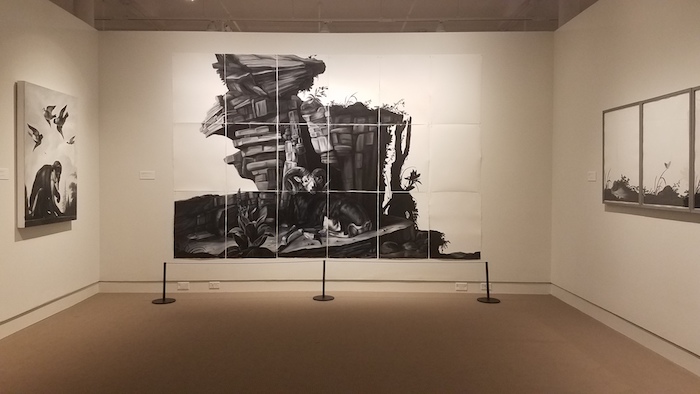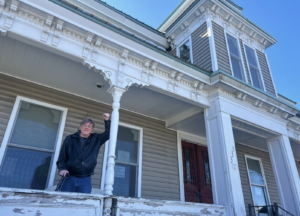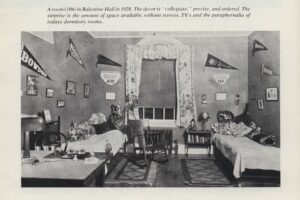Running from Sept. 14 through Dec. 29, Shelley Reed’s “Second Nature” is one of three exhibitions currently on display in the University of Maine Museum of Art (UMMA). In her 15 featured works, Reed uses monochrome oil paints to give her audience insight into art history, as well as human nature.
Reed’s pieces primarily depict animals in pastoral settings. Walking through the exhibit, there is an eerie feeling of animation that exudes from her two dimensional narratives. The paintings illustrate human-like emotions of fear, tranquility and vulnerability, reminding the audience that we are all, in fact, animals.
“While early painters used animals as decoration, artists from the 1700s and 1800s began depicting them in a more naturalistic way,” Reed said. “Not only were animals shown as trophies from the hunt or status symbols in menageries of the elite, they became stand-ins for people, often in narratives that showed them to be vain, silly or potentially treacherous. I use animals as metaphors for human nature—we have potential for such beauty, yet are capable of terrible villainy.”
Many of her pieces are inspired by the works of other artists, such as French Rococo painters Jean-Baptiste Oudry and Alexandre-François Desportes. Rococo art, also known as the late Baroque period, was an 18th-century style that focused on portraying lightness, elegance and curving natural forms.
“While I explore the meaning and symbolism these images had at the time they were painted, I’m mostly interested in how they can be reinterpreted and reintroduced today,” Reed said. “My work is a mash-up of these images—art history shaken and pieced back together to speak about how our animal natures have or haven’t changed, and what that might signify for our future.”
The biggest difference between Reed’s work and the work that inspires her appears in her choice of color pallet. While Rococo painters celebrated color, Reed limits herself to a grayscale. This creates a big contrast between how an audience interprets her work, and how the audience is used to viewing Rococo style.
“Color, which feeds our senses so thoroughly, is seductive and can end up being the main thing we appreciate about lots of art,” Reed said. “For me, a more monochromatic approach implies an echo of the past and almost sneakily calms things down, allowing me to enhance the psychological aspect—the gaze, the violence, the interpersonal dances. It allows one to look more closely and then maybe be surprised by the story being told.”
In her article, “Visualizations of Contemporary Paranoia,” art critic Candice Bancheri best described Reed’s ability to capture modern emotion through a historical lense.
“Camouflaged in a historicized aesthetic, Reed’s theatrical scenes harness a particular paranoia and chaos specific to the contemporary experience,” Bancheri continued, “With such insight, clarity, and a hint of incredulity imbedded in their theatricality and scale, Shelley Reed’s paintings pulse with vivacity, emotion, and best of all paranoia.”
Reed’s themes of mistrust and fear of what may be lurking in the shadows come through clearly in her piece “Ram (after Oudry, Bellini, Desportes, Mignon).” The piece depicts a ram tucked into what appears to be a mountain side. There is minimal vegetation, and the ram sits mouth agape partly hidden in the shadows. His eyes reflect fear and confusion, making the viewer question what might be coming around the corner.
“My parents’ lives were terribly impacted by the Holocaust. I believe my work reflects my feelings about humanity—that it is lush with beauty and possibility, yet there is always the possibility that something dangerous is about to happen,” Reed said.
This may be what makes Reed’s pieces so haunting. There is intimacy and vulnerability in the eyes of the animals she paints, almost as if they are waiting, unsure of what may come next.
“I hope a viewer will feel that, for a short while, they entered an environment inhabited by beings singing, tussling, snarling, or gazing right at them, and that this experience poses lingering questions about the narrative we create for ourselves and those around us,” Reed said.
To view “Second Nature,” as well as Darren Emenau’s “Olio” and “So Real” selections from the museum’s collection, visit the UMMA in downtown Bangor. UMMA is open Tuesday through Saturday between 10 a.m. and 5 p.m. with free admission.









